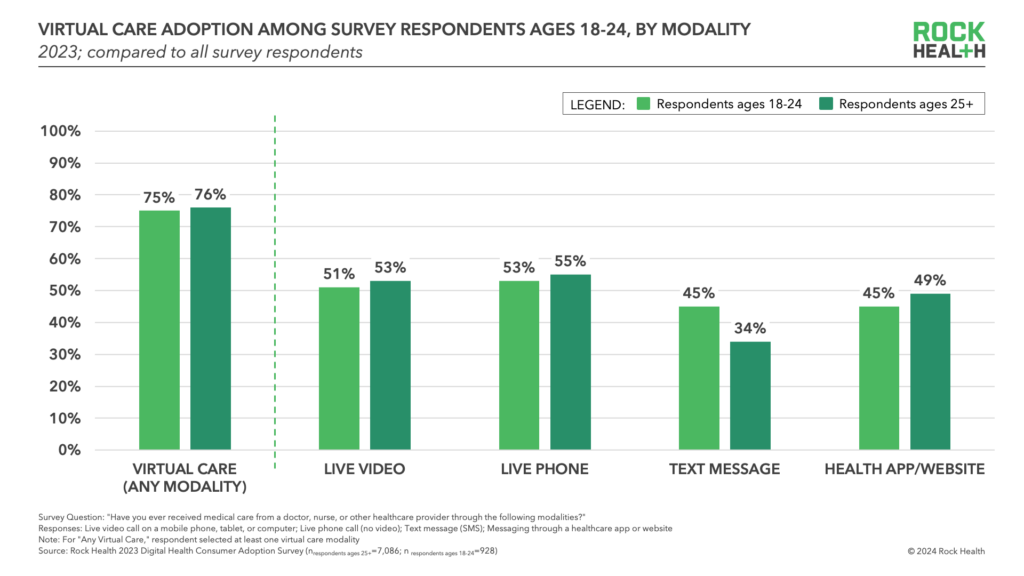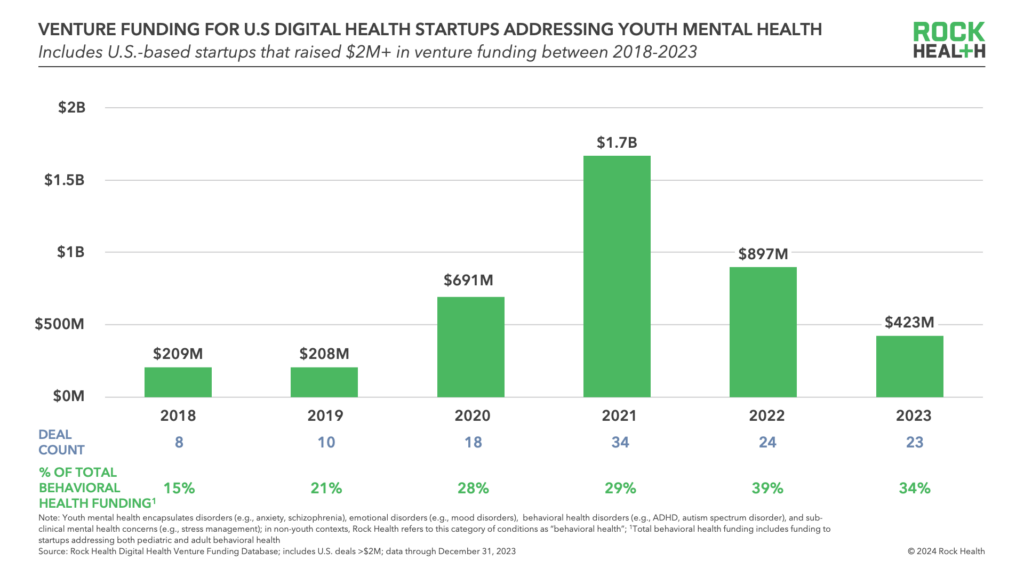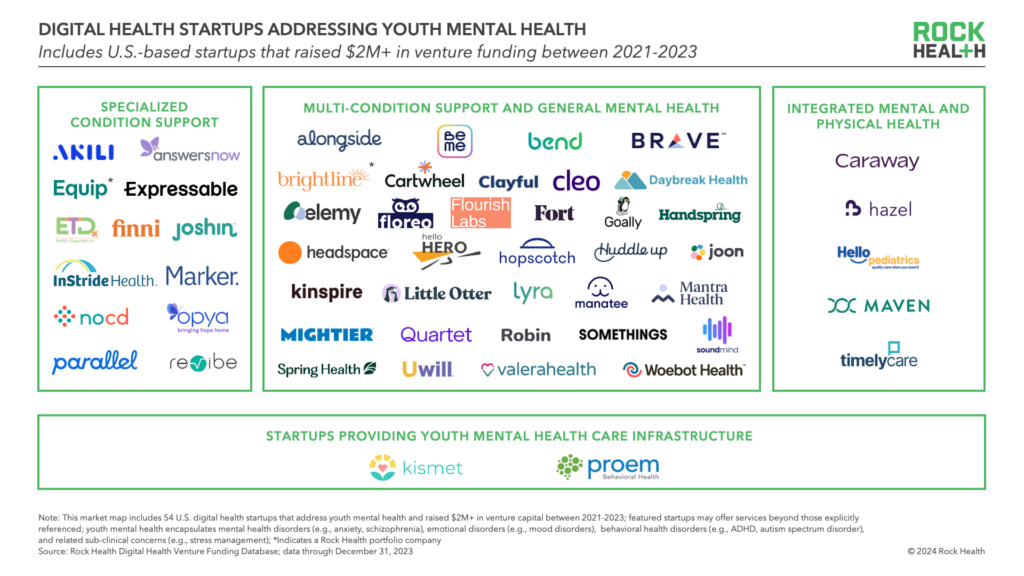Investing in the future: Supporting digital innovations in youth mental health
Acknowledgements: Special thanks to Pivotal, Penner Family Foundation, Hopelab, and the Arthur M. Blank Family Foundation, who supported this work
Today, more than 1 in 5 young Americans (21.8%) experience a mental or behavioral health disorder. Supporting youth mental health is a national priority, and new models of care are needed to increase access to mental healthcare—especially for young people whose experiences are impacted by their race, gender and sexual identity, family structure, or other factors.
There’s a unique opportunity for digital health to play a role. Young people today are true digital natives, using technology in all facets of their lives. Digital solutions can provide affordable, scalable, and personalized care in ways that match how young people already communicate. If digital health tools can successfully support earlier interventions and tailor resources to be culturally sensitive and age-appropriate, the sector has a real chance at making youth mental health care more inclusive and effective.
However, digital youth mental health programs must be built with intention and informed by what is currently working and what gaps remain. To address this, RockHealth.org launched the Digital Youth Mental Health Initiative in 2024, in partnership with impact-driven collaborators Pivotal, Fiore Ventures, Hopelab, and the Arthur M. Blank Family Foundation.
As part of this initiative, we developed a detailed report that explores today’s market dynamics, funding trends, and solution types in youth mental health to help investors and innovators navigate the opportunity. Read on for key insights from the research, and explore in more detail via the full report.
A note on definitions:
In this blog and report, we use the term “youth” to refer to individuals ages 2-24, including children, adolescents, teenagers, and young adults. “Mental health” encapsulates mental disorders (e.g., anxiety, schizophrenia), behavioral health disorders (e.g., attention deficit hyperactivity disorder, or ADHD), developmental disorders (e.g., autism spectrum disorder, or ASD), and substance use disorders that young people may experience.1
Young people and digital tools: Understanding the nuance
The relationship between young people and the digital world is complex. While online spaces can contribute to issues like social media addiction and cyberbullying, they also create forums where young people go to find help and community. Youth aren’t just open to digital mental health solutions—many are actively seeking them out. A 2023 national survey by Hopelab showed that over a quarter (26%) of respondents ages 14-22 had already tried online therapy, with usage rates higher among Black and Latino respondents ages 18-24 compared to their white peers.
Young people also use digital tools differently than other generations, something digital health developers need to research and design for. In one example from Rock Health’s 2023 Consumer Adoption of Digital Health Survey, while using virtual care at similar rates to the general population, 45% of respondents ages 18-24 reported using text-based virtual care tools, a rate 11 percentage points higher than the survey average for respondents ages 25 and older.

Investment dynamics
Behavioral health has been a top-funded therapeutic area in digital health for several years, with investment driven by the high demand for mental health services, especially during and after the COVID-19 pandemic.2 Historically, youth mental health has been underfunded relative to other behavioral health needs, but the landscape is shifting. In 2018, raises by digital health startups addressing youth mental health made up 15% of investment dollars in digital behavioral health—by 2023 they made up 34 percent. Seed and Series A fundraises accounted for 79% of 2023’s labeled deals in the category, which points to a surge in early-stage startups focused on youth mental health needs.

The digital youth mental health startup landscape
To understand the current landscape, we analyzed U.S.-based digital health startups addressing youth mental health that raised $2M+ in venture funding between 2021-2023. Segmenting recently-funded startups by the conditions they address:
- 24% focus on single conditions like ADHD, autism spectrum disorder, or serious mental illness, often developing products or programs tailored to these needs
- 63% address multiple mental health conditions, helping young people articulate their needs, obtain diagnoses, and connect with appropriate providers and treatments
- 9% integrate mental and physical healthcare, enabling holistic care through collaboration between pediatricians, primary care doctors, and behavioral health specialists
- 4% develop digital infrastructure for youth mental health data and care delivery—e.g., building health records and data management software, powering clinical platforms, and training large language models (LLMs)

Most digital health startups in the space offer virtual care and coaching programs (72%), self-directed digital support tools (43%), or both (26%). Many of those that offer virtual care and coaching programs focus on expanding access to mental healthcare to young people that have limited access to trained behavioral health providers, like those enrolled in Medicaid or CHIP programs or who have complex mental illnesses.3 Eighty-seven percent of startups with virtual care and coaching startups use therapists, counselors, or social workers to deliver teletherapy. Thirty-six percent deliver behavioral support via certified coaches, sometimes in combination with clinical therapy.4
Digital health startups addressing youth mental health are using different go-to-market pathways. Business model strategies are currently diverse, and success stories in today’s startup class will help solidify pathways for the next generation of players. Analyzing the 2021-2023 startup cohort, 65% of startups contract with commercial health plans or employers, with outcomes tied to reducing overall healthcare spend, increasing employee satisfaction, and reducing employee absenteeism (employees being parents of young people using the solutions). Fifty percent sell direct-to-consumers ages 18+ or to parents of youth. Only 22% contract with state Medicaid programs or managed care organizations (MCOs), even though nearly half of young people in the U.S. are Medicaid beneficiaries.
Helping innovators and investors drive change
For those looking to invest in or partner with digital health startups addressing youth mental health, it’s important to understand the design and business principles that potential partners have in place. Helpful guiding questions:
- Is the product or program designed specifically for young people?
Effective youth mental health tools aren’t just “miniaturized” versions of adult resources. Solutions should be designed based on how young people express mental health needs, work through problems, and use technology. Young people should give feedback on product iterations.
- Can the startup team support different youth communities?
Assess if/how potential partners are set up to address the unique needs of groups like LGBTQ+ youth, Black and Latino youth, young people who are caregivers, or those who face housing insecurity. - Does the solution demonstrate meaningful clinical outcomes?
Mental health tools must demonstrate clinically-proven benefits. Accessibility and cost outcomes should enhance, not detract from, that clinical effectiveness. - Are data protection and youth privacy prioritized?
Especially with users younger than 18, there are dangerous ramifications of data being hacked or shared without consent. Policies for sharing data with parents and caregivers should be designed with respect for youth agency and privacy. - Are there clear plans to overcome barriers to scale?
Certain product types or go-to-market approaches have higher barriers to scale than others—such as the need for startups working with Medicaid to contract with individual states. Ensure that startup partners have a good understanding of the barriers ahead and plans for addressing.
Supporting youth mental health nationwide is a formidable task, but it also represents a unique opportunity with large market potential. As the digital youth mental health market continues to grow, the opportunity for innovation to make a profound impact on the well-being of young people is immense.
Dive deeper into the solution landscape and learn more about digital innovations in youth mental health:
To get the latest information on RockHealth.org’s Youth Mental Health Initiative, click here. To learn more about this exciting effort or explore potential collaboration opportunities, please reach out to the RockHealth.org team at hello@rockhealth.org.
Join us in building a more equitable future at RockHealth.org.
Tap into insights and strategic guidance for enterprise companies with Rock Health Advisory.
Get in touch with the venture team at Rock Health Capital.
And last but not least, stay plugged into the Rock Health community and all things digital health with the Rock Weekly.
Footnotes
- For the purposes of this publication, we felt it was important to include behavioral, developmental, and substance use disorders, which have deep impacts on young people’s mental and emotional experiences, within our definition of youth mental health. In other blog posts, Rock Health uses the term “behavioral health” to refer to the combined category of mental disorders, behavioral disorders, developmental disorders, and substance use disorders.
- “Youth mental health” encapsulates mental health disorders (e.g., anxiety, schizophrenia), emotional disorders (e.g., mood disorders), behavioral health disorders (e.g., ADHD, autism spectrum disorder), and sub-clinical mental health concerns (e.g., stress management). In other contexts, Rock Health refers to this category of conditions as “behavioral health.”
- Equip Health is a Rock Health portfolio company.
- Because some digital health startups addressing youth mental health employ or contract multiple provider types, these percentages exceed 100%.


